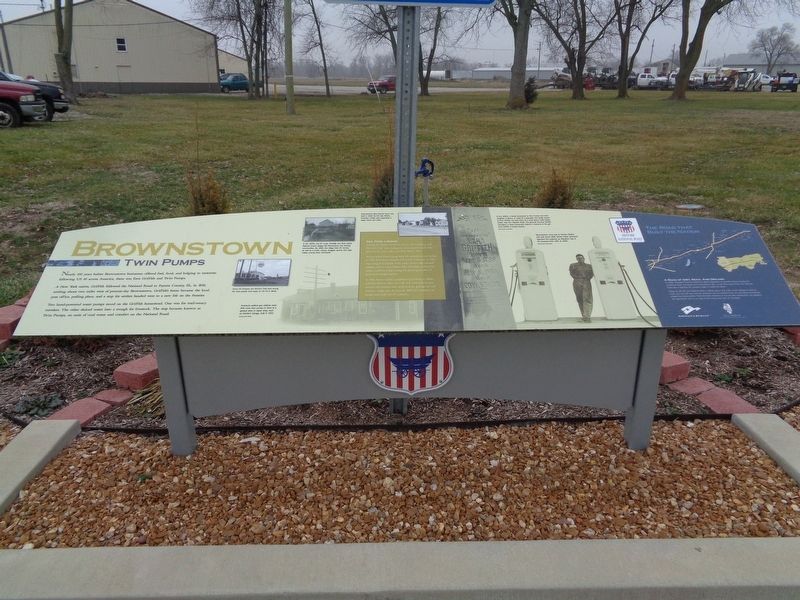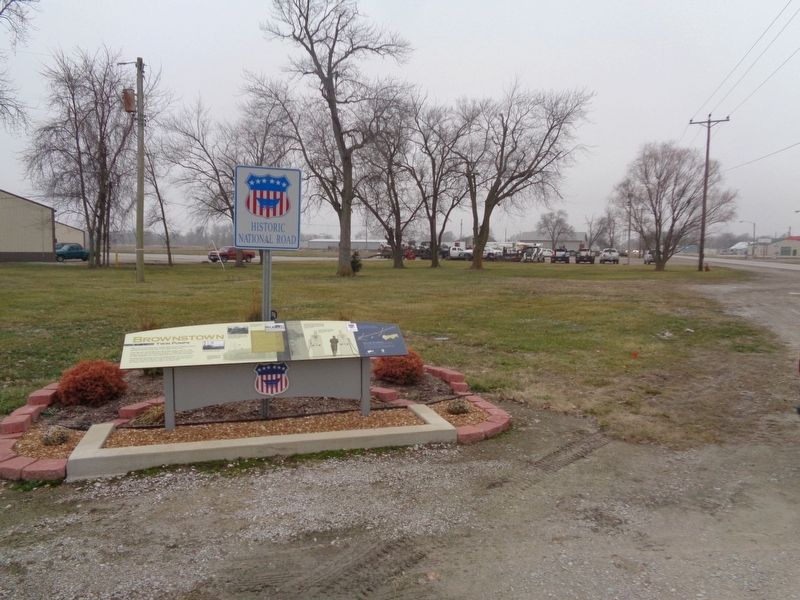Brownstown in Fayette County, Illinois — The American Midwest (Great Lakes)
Brownstown
Twin Pumps
A New York native, Griffith followed the National Road to Fayette County, Ill., in 1830, settling about two miles west of present-day Brownstown. Griffith's home became the local post office, polling place, and a stop for settlers headed west to a new life on the frontier.
Two hand-powered water pumps stood on the Griffith homestead. One was for trail-weary travelers. The other sluiced water into a trough for livestock. The stop became known as Twin Pumps, an oasis of cool water and comfort on the National Road.
Gas, Food, Lodging
During the heyday of US 40, Dycus Oil Company and McCoy's Café were among the most popular truck stops between St. Louis, Mo., and Terre Haute, Ind.
Texaco dealer Floyd Dycus built his roadside service station in 1925. Paul Reece bought Dycus Oil Company in 1929, expanding it to include truck repair. Reece sold essential supplies such as wiper blades, belts and hoses, making his station a preferred stop among the growing number of professional freight haulers.
In 1936, Reece rented a neighboring building to Merle and Bess McCoy. McCoy's Café was a hit with hungry tourists and truckers who saved time by getting fuel and food at a single stop. At its peak, McCoy's employed 30 people and could seat 78 customers.
Photo captions:
Dycus Oil Company and McCoy's Café were among the most popular truck stops on US 40 in Illinois.
America's earliest gas stations were little more than pumps in front of a general store or repair shop, such as Greider's Garage, built in 1921.
In the 1870s, the St. Louis, Vandalia and Terre Haute Railroad turned villages like Brownstown into thriving communities. By 1880, the village held 25 homes, as well as a smith, cooper, druggist, grocer, and cigar maker, among other merchants.
Brownstown's Blue Bonnet Court was built in 1939. By the late 1940s, franchise motels were appearing in larger towns and cities.
In the 1850s, a family encamped at Twin Pumps lost their daughter to illness. In need of a gravesite, the family turned to Ezra Griffith. He sent them to a knoll above Little Sandy Creek, near the National Road. The grounds became Griffith Cemetery. A stone monument stands in memory of the girl. Ezra Griffith is buried nearby.
Brownstown's Linco Gas & Service Station was built about 1918. Grover Fisher (pictured) operated the business as Marathon Gas & Oil Company from 1951 to 1958.
(aside:)
A Road of Dirt, Rock, And Dreams
In 1806, President Thomas Jefferson signed legislation to provide federal funding for a National Road. Surveyed from Cumberland, Md., to the Mississippi River, the National Road was a highway for pioneers eager to settle the West.
Today, as US 40, the National Road in Illinois spans 164 miles. From Indiana to East St. Louis, you can still see how the ambitions and accomplishments of early Illinois immigrants shaped our communities. You'll find their influence in our art and architecture, our industry and agriculture, and in our way of life. Enjoy your time on the Road.
Erected 2015 by National Road Association of Illinois.
Topics and series. This historical marker is listed in these topic lists: Cemeteries & Burial Sites • Communications • Industry & Commerce • Roads & Vehicles. In addition, it is included in the The Historic National Road series list. A significant historical year for this entry is 1830.
Location. 38° 59.505′ N, 88° 57.084′ W. Marker is in Brownstown, Illinois, in Fayette County. Marker is at the intersection of East Cumberland Road (U.S. 40) and South 3rd Street, on the right when traveling east on East Cumberland Road. Marker is across from the Brownstown Fire Protection station. Touch for map. Marker is at or near this postal address: 102 East Cumberland Road, Brownstown IL 62418, United States of America. Touch for directions.
Other nearby markers. At least 8 other markers are within 8 miles of this marker, measured as the crow flies. Brownstown Area Veterans Memorial (approx. 0.2 miles away); St. Elmo Area Veterans Memorial (approx. 5.8 miles away); St. Elmo (approx. 5.8 miles away); Site of Ernst Hotel (approx. 7.9 miles away); House of Divine Worship (approx. 7.9 miles away); Site of Blackwell's White House (approx. 7.9 miles away); Internal Improvements (approx. 7.9 miles away); Robert K. McLaughlin Home (approx. 7.9 miles away).
Also see . . . St. Elmo and Brownstown. From the Illinois National Road's YouTube channel, this is a short video that talks about the villages of St. Elmo and Brownstown. The segment on Brownstown starts at 2:38.
(Submitted on January 7, 2020, by Jason Voigt of Glen Carbon, Illinois.)
Credits. This page was last revised on January 8, 2020. It was originally submitted on January 7, 2020, by Jason Voigt of Glen Carbon, Illinois. This page has been viewed 473 times since then and 59 times this year. Photos: 1, 2. submitted on January 7, 2020, by Jason Voigt of Glen Carbon, Illinois. • Devry Becker Jones was the editor who published this page.

